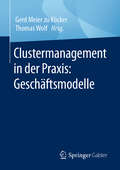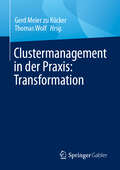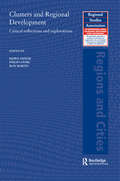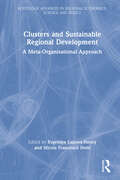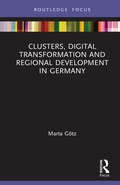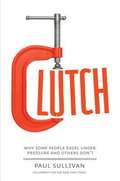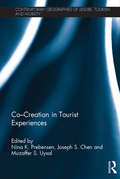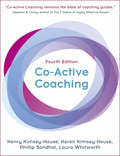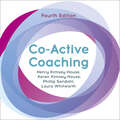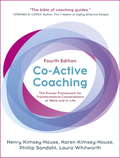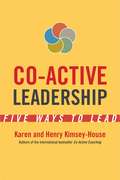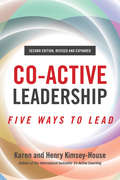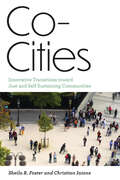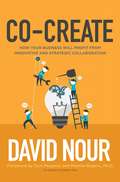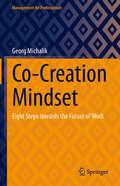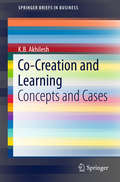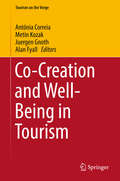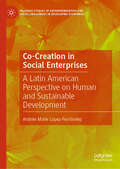- Table View
- List View
Clustermanagement in der Praxis: Geschäftsmodelle
by Thomas Wolf Gerd Meier zu KöckerIn der regionalen Wirtschaftsentwicklung nehmen Clusterinitiativen eine große Bedeutung ein, gerade wenn es um die Steigerung von Innovationskraft bei kleineren und mittleren Unternehmen geht. Doch wie lassen sich Clusterinitiativen sinnvoll als Instrument in die Regionalentwicklung einbetten und wie kann gutes Clustermanagement als zentrale Schlüsselfunktion aussehen, damit die Netzwerke ihr volles Potenzial entfalten können?In den letzten Jahren gab es vermehrt gelungene Beispiele dafür, wie Clusterinitiativen Mehrwerte im Sinne ihrer Akteure generieren können. Dieses Buch stellt erfolgreiche Geschäftsmodelle von Clusterinitiativen vor und gibt einen Überblick über die Chancen und Herausforderungen im täglichen Geschäft. Es bietet eine praxisorientierte Hilfestellung und viele Best-Practice-Beispiele speziell für Clustermanager, aber auch für Wirtschaftsförderungen, Kommunen, Verwaltung, Unternehmen, Wissenschaft, Verbände und Vereine.
Clustermanagement in der Praxis: Transformation
by Thomas Wolf Gerd Meier zu KöckerIn der regionalen Wirtschaftsentwicklung nehmen Clusterinitiativen eine große Bedeutung ein, gerade wenn es um die Steigerung von Innovationskraft bei kleineren und mittleren Unternehmen geht. Doch wie lassen sich Clusterinitiativen sinnvoll als Instrument in die Regionalentwicklung einbetten und wie kann gutes Clustermanagement als zentrale Schlüsselfunktion aussehen, damit die Netzwerke ihr volles Potenzial entfalten können? In den letzten Jahren gab es vermehrt gelungene Beispiele dafür, wie Clusterinitiativen Mehrwerte im Sinne ihrer Akteure generieren können. Dieses Buch stellt erfolgreiche Transformationen von Clusterinitiativen vor und gibt einen Überblick über die Chancen und Herausforderungen im täglichen Geschäft. Es bietet eine praxisorientierte Hilfestellung und viele Best-Practice-Beispiele speziell für Clustermanager, aber auch für Wirtschaftsförderungen, Kommunen, Verwaltung, Unternehmen, Wissenschaft, Verbände und Vereine.
Clustermanagement: Wie Cluster die Innovation und die Wettbewerbsfähigkeit unterstützen
by Eduard HauserDas Buch zeigt die Ausgangslage f#65533;r den Aufbau von Clustern in der Schweiz und stellt anhand einiger Beispiele aus unterschiedlichen Branchen dar, wie Cluster erfolgreich sein k#65533;nnen. Es werden internationale Ans#65533;tze zur St#65533;rkung von Netzwerken dargestellt, Checklisten liefern Hinweise f#65533;r Praktiker, die Cluster lancieren wollen.
Clusters and Regional Development: Critical Reflections and Explorations (Regions and Cities)
by Ron Martin Philip Cooke Bjørn AsheimUsing international examples, leading scholars present the first critical analysis of cluster theory, assessing the cluster notion and drawing out, not only its undoubted strengths and attractions, but also its weaknesses and limitations. Over the past decade the ‘cluster model’ has been seized on as a tool for promoting competitiveness, innovation and growth on local, regional and national scales. However, despite its popularity there is much about it that is problematic, and in some respects the rush to employ ‘cluster ideas’ has run ahead of many fundamental conceptual, theoretical and empirical questions. Addressing key questions on the nature, use and effectiveness of cluster models, Clusters and Regional Development provides the missing thorough theoretical and empirical evaluation.
Clusters and Sustainable Regional Development: A Meta-Organisational Approach (Routledge Advances in Regional Economics, Science and Policy)
by Evgeniya Lupova-Henry Nicola Francesco DottiClusters and Sustainable Regional Development conceptualises the role of organised clusters in the transition towards sustainability. It introduces a novel perspective on these clusters, viewing them as deliberate collective actors within their environments that can become the driving force for transformation in their regions or nations. The book draws upon the meta-organisational perspective in cluster studies, in contrast to traditional approaches. This view suggests that clusters are not merely territories or geographical areas, but organised entities. As such, they are defined as territorially anchored groups of independent organisations engaging in joint decision-making, pursuing system-level goals and capable of purposive collective action. This text introduces a new set of ideas and questions at the intersection of economic geography, regional and cluster studies, organisation and management, policy and governance research. It will appeal to researchers from these diverse fields seeking to further develop the meta-organisational view of clusters as well as conceptualise their role in sustainability transitions. This book will also be a useful guide for policymakers who have an interest in the dynamics of economic development and the transition towards sustainability.
Clusters and the New Economics of Competition
by Michael E. PorterIn this article, Michael Porter, the C. Christensen Professor of Business Administration at the Harvard Business School, explains how clusters foster high levels of productivity and innovation and lays out the implications for competitive strategy and economic policy. Economic geography in an era of global competition poses a paradox. In theory, location should no longer be a source of competitive advantage. Open global markets, rapid transportation, and high-speed communications should allow any company to source any thing from any place at any time. But in practice, location remains central to competition. Today's economic map of the world is characterized by what Porter calls clusters: critical masses in one place of linked industries and institutions--from suppliers to universities to government agencies--that enjoy unusual competitive success in a particular field. The most famous examples are found in Silicon Valley and Hollywood, but clusters dot the world's landscape. Porter explains how clusters affect competition in three broad ways: first, by increasing the productivity of companies based in the area; second, by driving the direction and pace of innovation; and third, by stimulating the formation of new businesses within the cluster. Geographic, cultural, and institutional proximity provides companies with special access, closer relationships, better information, powerful incentives, and other advantages that are difficult to tap from a distance. The more complex, knowledge-based, and dynamic the world economy becomes, the more this is true. Competitive advantage lies increasingly in local things--knowledge, relationships, and motivation--that distant rivals cannot replicate.
Clusters in Automotive and Information & Communication Technology: Innovation, Multinationalization and Networking Dynamics
by Paul J.J. WelfensInformation & communication technology (ICT) and the automotive sector are two of the most important industries in the EU and the US. The EU's eastern expansion and economic globalization have reinforced competition on the one hand; on the other hand the importance of outsourcing and off-shoring has increased. Against this background the intensification of innovation dynamics becomes crucial - and with them the role of regional innovation clusters. The analysis examines seven regions and six EU countries. The focus is on cluster and network dynamics in both industries, as regional ICT clusters are playing an increasingly central role in many European regions. Specialization and structural change in the automotive sector are highlighted, and new strategic approaches for multinational companies and changes in policy options are identified.
Clusters, Digital Transformation and Regional Development in Germany (Routledge Focus on Business and Management)
by Marta GötzThe information age is reshaping current socio-economic structures and processes and this book touches upon the nature of clusters in the fourth industrial revolution (Industry 4.0; I4.0). It focuses on the spatial perspective of digital business transformation and explores in natural context the interrelations between cluster and I4.0. It investigates the role of knowledge, business relations and policy in making cluster relevant for Industry 4.0 and uses the case study method and literature review to develop a conceptual framework outlining the functioning of Industry 4.0 cluster. This book argues that locally embedded knowledge accompanied by strong presence of industry and assisted by proper governance management facilitate the implementation of I4.0. The idiosyncrasies of Industry 4.0 impact also the functioning of cluster as they require more interdisciplinary integrative approach with the provision of industrial commons and development of related varieties. Natural processes of stretching of the cluster cannot be prevented, but should be harnessed for upgrading the core competences of cluster. This book can enrich existing literature on economic geography and regional studies by discussing the spatial aspects of digital transformation. It shows the cluster transformation as induced by the digital transformation, and will be of interest to researchers, academics, policymakers, and students who explore the regional and local development, competitiveness, or managerial aspects of fourth industrial revolution.
Clutch
by Paul Sullivan"Anyone who feels that they tend to lose their confidence when the stakes are high can glean something from this analysis. "-The Associated Press Sooner or later everyone encounters a situation in which the stakes are high and the outcome is vital. And even top performers can crumble when faced with such extreme pressure. But then there are the performers who thrive under such conditions. In Clutch, you'll meet: A skinny sergeant who saved his battalion in Iraq A rookie baseball player who pitched his team into its first World Series A lawyer who struggled in school but became one of the top litigators in America According to Sullivan, clutch performance does not stem from an innate ability. It's a learned skill-the art of operating in high- stress situations as if they were everyday conditions. Even some of the most experienced and talented performers lack this skill-but Sullivan shows that anyone can develop it. .
Clutch Group: Should Abhi Shah Grab This Opportunity?
by Daniel J. IsenbergAbhi Shah ('06) co-founding CEO of Clutch Group in the US and Bangalore, must decide whether to risk a law suit by recruiting an entire legal services team from a large US corporation. His decision and how he implements it will have a dramatic impact on the legal process outsourcing startup.
Clutch Group: Should Abhi Shah Grab This Opportunity?
by Daniel J. IsenbergAbhi Shah ('06) co-founding CEO of Clutch Group in the US and Bangalore, must decide whether to risk a law suit by recruiting an entire legal services team from a large US corporation. His decision and how he implements it will have a dramatic impact on the legal process outsourcing startup.
Co - Creation in Tourist Experiences (Contemporary Geographies of Leisure, Tourism and Mobility)
by Nina K Prebensen Joseph S Chen Muzaffer S UysalThe tourist experience is multi-faceted and dynamic, as tourists engage with its formation and creation. The tourists then become vital in creating value for themselves together with the service provider. Experience value cannot be pre-produced, but is co-created between host and guest(s) in the servicescape. The tourist managers can therefore only plan for and facilitate for value co-creation to take place. This book responds to the need for a critical review of how firms can facilitate and dramatize for enhanced experience value for tourists. As the roles of participants and providers are changing rapidly, new knowledge in terms of how value creation and value co-creation can transpire needs to be generated. The aim of this book is therefore to accentuate the role and importance of the core elements in value creation processes, namely, the customer(s), the setting in which co-creation would take place, and the provider. Bringing together scholars from diverse areas to address the nature of how the actors co-create values through interaction in different experience settings, the book also serves as a guide to the best practice of co-creation of tourist experiences. It will therefore appeal practically as well as theoretically to scholars and students of tourism, marketing, leisure, hospitality, and services management.
Co-Active Coaching, Fourth Edition: The proven framework for transformative conversations at work and in life
by Laura Whitworth Henry Kimsey-House Karen Kimsey-House Phillip SandhalThe new 4th edition of the cultural and business phenomenon that helped launch the professional practice of coaching!'The bible of coaching guides...No other book gives you the tools, skills, and the fundamentals needed to succeed in these delicate relationships.' Stephen R. Covey, Author of The 7 Habits of Highly Effective PeopleThis extensively revised 4th edition now offers leaders, managers and other business professionals practical guidance for embracing coaching as a core competency to drive greater workplace engagement.The flexible Co-Active Coaching model showcased in the book has stood the test of time as a transformative communication process that co-workers and teammates, managers, teachers, and students can use to build strong and collaborative relationships. In this highly-anticipated new edition, the authors capture their broader experience in applying the Co-Active approach to leadership and human development. The book reflects today's reality of how coaching has moved beyond its initial focus on life skills to become an integral aspect of successful leadership development. It provides the latest terminology and a variety of fresh coaching examples drawn from the authors' first-hand experiences with thousands of international coaching trainees and clients.The power-packed on-line Coach's Toolkit has been expanded to include more than 35 exercises, questionnaires, checklists to make these proven principles and techniques accessible and practical. Full of thoughtful exercises, relevant examples and concrete advice, this text is clear, direct, easy to read, and inspiring.
Co-Active Coaching: Changing Business, Transforming Lives
by Laura Whitworth Henry Kimsey-House Karen Kimsey-House Phillip SandahlWith the first edition, the authors of Co-Active Coaching earned their place at the forefront of the coaching profession. Now, this fully revised third edition of their classic work extends the use of their pioneering Co-Active model - which emphasizes a partnership between client and coach - into leadership management throughout an organization. This new edition has been updates to include fresh coaching examples, the latest in coaching terminology and an expanded, web-based 'Coach's Toolkit'. Used as the definitive resource in dozens of professional development programs, Co-Active Coaching teaches the transformative communication process that allows individuals from all levels of an organization - from students to teachers, and direct reports to managers - to build strong, collaborative relationships.
Co-Active Coaching: The Proven Framework for Transformative Conversations at Work and in Life
by Laura Whitworth Henry Kimsey-House Karen Kimsey-House Phillip SandahlThe definitive edition - updated and expanded, with access to an online toolkit.'The bible of coaching guides...No other book gives you the tools, skills, and the fundamentals needed to succeed in these delicate relationships.' Stephen R. Covey, Author of The 7 Habits of Highly Effective PeopleCo-Active Coaching offers current and aspiring coaches, leaders and managers in organisations and anyone wanting to strengthen interpersonal relationships, a practical, yet transformative communication process called the Co-Active Model. Since its creation by the authors more than 25 years ago, the Co-Active Model and the book have formed the foundation of the authors' six-part coach training program delivered globally to tens of thousands of individuals each year through the authors' training institute, CTI. With its origins in the coaching profession, the Co-Active Model also applies to work and interpersonal relationships because it is based on principles of effective communication backed by current scientific research. In this highly-anticipated new edition, the universal applicability of the the Co-Active Model is emphasised. It goes beyond the one-on-one coach/coachee structure to include guidance for leaders and managers on how they can add a coaching competency to their professional skill set.New to this edition:· Every chapter has been updated for relevance and direct application to coaching in all of its forms, including in the workplace· New material covering: current neuroscience research, Co-Active approaches to leadership development and working with groups and teams· More examples drawn from the authors' first-hand experiences, especially in workplace settings · More examples of the Co-Active Model applied internationally· Web-based 'Toolkit' with 27 exercises, questionnaires, checklists, and reproducible forms(P)2019 Hodder & Stoughton Limited
Co-Active Coaching: The proven framework for transformative conversations at work and in life - 4th edition
by Laura Whitworth Henry Kimsey-House Karen Kimsey-House Phillip SandahlThe definitive edition - updated and expanded, with access to an online toolkit.'The bible of coaching guides...No other book gives you the tools, skills, and the fundamentals needed to succeed in these delicate relationships.' Stephen R. Covey, Author of The 7 Habits of Highly Effective PeopleCo-Active Coaching offers current and aspiring coaches, leaders and managers in organisations and anyone wanting to strengthen interpersonal relationships, a practical, yet transformative communication process called the Co-Active Model. Since its creation by the authors more than 25 years ago, the Co-Active Model and the book have formed the foundation of the authors' six-part coach training program delivered globally to tens of thousands of individuals each year through the authors' training institute, CTI. With its origins in the coaching profession, the Co-Active Model also applies to work and interpersonal relationships because it is based on principles of effective communication backed by current scientific research. In this highly-anticipated new edition, the universal applicability of the the Co-Active Model is emphasised. It goes beyond the one-on-one coach/coachee structure to include guidance for leaders and managers on how they can add a coaching competency to their professional skill set.New to this edition:· Every chapter has been updated for relevance and direct application to coaching in all of its forms, including in the workplace· New material covering: current neuroscience research, Co-Active approaches to leadership development and working with groups and teams· More examples drawn from the authors' first-hand experiences, especially in workplace settings · More examples of the Co-Active Model applied internationally· Updated/fine-tuned glossary (less jargon) · Web-based 'Toolkit' with 27 exercises, questionnaires, checklists, and reproducible forms
Co-Active Leadership
by Henry Kimsey-House Karen Kimsey-HouseA Multidimensional Approach to LeadershipTop-down, one-dimensional leadership models are hopelessly outmoded in today's rapidly changing world, and they waste the leadership ability that is present throughout an organization. In this visionary book, Karen and Henry Kimsey-House provide a model that harnesses the possibility of many rather than relying on the power of one. Their revolutionary five-dimensional approach recognizes that leadership has to be fluid and flexible and that the roles leaders and followers play must shift to suit the situation. Co-Active Leadership invites all of us to share our expertise and allows collaborative solutions to emerge that would never have been possible otherwise.
Co-Active Leadership, Second Edition: Five Ways to Lead
by Henry Kimsey-House Karen Kimsey-HouseAs leaders, how we are is as important as what we do. The second edition of this leadership classic, updated with new chapters, shows how to master the inner and outer work needed to build relationships that unleash the transformational creative potential in everyone.We need to expand beyond top-down, one-dimensional leadership models and find alternatives that are more fluid and inclusive and that harness the possibility of many rather than relying on the power of one. This is exactly what Karen and Henry Kimsey-House provide in this groundbreaking book. Co-Active Leadership is a deeply collaborative approach, which is why the first of its five dimensions is leading from within: self-leadership. Leaders must be fully present and live lives of integrity, openheartedness, and self-awareness if they are to make the kind of conscious, creative choices Co-Active Leadership demands.Each of the remaining four dimensions work together holistically. Depending on the situation, you may lead from the front, offering guidance and inspiration; from behind, supporting and encouraging others; from beside, partnering with and supporting other members of your team; or from the field, drawing on insights and wisdom available beyond the rational mind.This edition includes two new chapters, one offering new ways to utilize the Co-Active Leadership Model and another that goes deeply into the Co-Active philosophy. Co-Active Leadership celebrates and honors different expressions of leadership. It invites all of us to share our expertise and allows collaborative solutions to emerge that would never have been possible otherwise.
Co-Cities: Innovative Transitions toward Just and Self-Sustaining Communities (Urban and Industrial Environments)
by Sheila R. Foster Christian IaioneA new model of urban governance, mapping the route to a more equitable management of a city&’s infrastructure and services.The majority of the world&’s inhabitants live in cities, but even with the vast wealth and resources these cities generate, their most vulnerable populations live without adequate or affordable housing, safe water, healthy food, and other essentials. And yet, cities also often harbor the solutions to the inequalities they create, as this book makes clear. With examples drawn from cities worldwide, Co-Cities outlines practices, laws, and policies that are presently fostering innovation in the provision of urban services, spurring collaborative economies as a driver of local sustainable development, and promoting inclusive and equitable regeneration of blighted urban areas. Identifying core elements of these diverse efforts, Sheila R. Foster and Christian Iaione develop a framework for understanding how certain initiatives position local communities as key actors in the production, delivery, and management of urban assets or local resources. Within this framework, they explain the forms such initiatives increasingly take, like community land trusts, new kinds of co-housing, neighborhood cooperatives, community-shared broadband and energy networks, and new local offices focused on citizen science and civic imagination. The &“Co-City&” framework is uniquely rooted in the authors&’ own decades-long research and first-hand experience working in cities around the world. Foster and Iaione offer their observations as &“design principles&”—adaptable to local context—to help guide further experimentation in building just and self-sustaining urban communities.
Co-Create: How Your Business Will Profit from Innovative and Strategic Collaboration
by David NourWhat if your customers had a vested interest in guiding your company toward greater success? What if your employees had a personal as well as professional commitment to elevating your organization? Imagine how different your results would be if investors, vendors, and even analysts treasured the relationship they have built with you?Most important . . . is your company capable of setting aside a bit of its own self-interest to become part of dramatically more rewarding collaborative effort? That’s the provocative and ultimately earthshaking question David Nour poses. He argues that co-creation is a transformational journey that naturally leads to growth and evolution . . . because it gives birth to shared interests that dwarf anything that existed previously.In Co-Create, David Nour makes the case that co-creation leads to Market Gravity™, a force that attracts stakeholders to your business because they recognize that many others have also united their interests with yours. It’s the sense—backed by tangible metrics—that this is bigger than any of us imagined . . . except that you imagined precisely such an outcome. That’s the power of co-creation.
Co-Creating Tourism Research: Towards Collaborative Ways of Knowing (Contemporary Geographies of Leisure, Tourism and Mobility)
by Carina Ren Gunnar Thór Jóhannesson René Van Der DuimCo-creation has become a buzzword in many social science disciplines, in business and in tourism studies. Given the prominence of co-creation, surprisingly little discussion has evolved around its implications for research practices and knowledge production as well as what challenges there are for fulfilling the promise of co-creation in tourism research. This book aims to contribute to this discussion by addressing how tourism research comes together as a collaborative achievement and by exploring different ways of collaborative knowledge production in tourism research. It is structured to offer, on one hand, an introduction to the ontological basis for collaborative research and, on the other hand, a set of empirical examples of how collaborative knowledge creation can inform tourism design, management, policy and education. The theoretical accounts and empirical cases of this book display how research collaborations can offer modest, local yet often impactful insights, traces and effects. It therefore will be of value for students, researchers and academics in tourism studies as well as the wider social sciences.
Co-Creation Mindset: Eight Steps towards the Future of Work (Management for Professionals)
by Georg MichalikCo-creation is a major trend in management, yet no one seems to truly know what it is. With numerous examples and a Q&A section, this book explains exactly what co-creation is and how it differs from other forms of collaboration. To do so, it covers three main topics: innovation, trust and commitment. With regard to the first, co-creation creates a sense of psychological security by treating all participants as equals, the most important prerequisite for finding innovative solutions. In terms of trust, co-creation builds on individual strengths. People who believe in each other’s abilities trust each other. Lastly, co-creation allows people to arrive at win-win solutions, which is the foundation for taking personal ownership.The book is intended for executives, HR and organizational managers, and those responsible for corporate transformation who want to implement co-creation in a very concrete way, as well as anyone interested in co-creation in general.
Co-Creation and Learning: Concepts and Cases (SpringerBriefs in Business)
by K. B. AkhileshThis book introduces readers to co-creation --- a complex, value-based, context-driven and collaborative effort to develop new paradigms, products and services to satisfy human wants. Co-creation is built not only around the perceptions of challenges, cause-and-effect relationships and constraints, but also around available alternatives for dealing with or overcoming those challenges. Co-creation is not about transferring or outsourcing activities, and neither is it about the customization of products and services. This book explains the emergence of the co-creation approach. It describes various models of value creation, as well as different stages and the contract process involved in co-creation. It also explores different types of learning and learning techniques, and how co-creation impacts the learning process. The book allows practitioners and policymakers to understand the processes involved in implementing co-creation in any organization, while also presenting case studies to show how to apply the relevant concepts in their day-to-day activities.
Co-Creation and Well-Being in Tourism (Tourism on the Verge)
by Alan Fyall Metin Kozak Antónia Correia Juergen GnothThis book offers a wealth of new views and interpretations of well-being in tourism, emphasizing the role that co-creation - the creation or enhancement of value through tourist engagement with tourism providers and other tourists - is increasingly playing in enriching tourist experiences. A combination of theoretical and empirically based contributions relating to various tourism contexts shed light on existing and potential contributions of tourists and destination providers to tourist well-being. Readers will find novel and compelling insights into both the very nature of wellbeing as perceived by the tourist and the opportunities that are emerging as tourists become savvy decision-makers capable of activating their own networks and resources in order to shape their experiences. The book will be of interest for all who wish to learn more about the character and the construction of well-being within tourism, the relationship of well-being to a range of factors, and the ways in which tourism operators can assist tourists in creating high-value experiences.
Co-Creation in Social Enterprises: A Latin American Perspective on Human and Sustainable Development (Palgrave Studies of Entrepreneurship and Social Challenges in Developing Economies)
by Andrée Marie López-FernándezThis book provides insight into the historical background of Latin America and the Caribbean, focusing on the impacts of conquest, colonialism, and dictatorships, to examine the current state of institutions, organizations, and businesses to emphasize the critical need of social enterprises in fostering human and sustainable development. It explores how social accountability facilitates co-creation of value at both micro and macro levels, thereby, impacting regional and, ultimately, global growth and development. Addressing the root causes for the region lagging behind in growth and development, this volume proposes a model to plan strategically for the co-creation of added value, aimed at enhancing the well-being of current and future generations. Aimed at scholars interested in the effects of shared responsibility in social enterprise dynamics, this book offers an understanding of the origins of social issues in Latin America and the Caribbean and creates a path for four different groups of stakeholders to take action.
